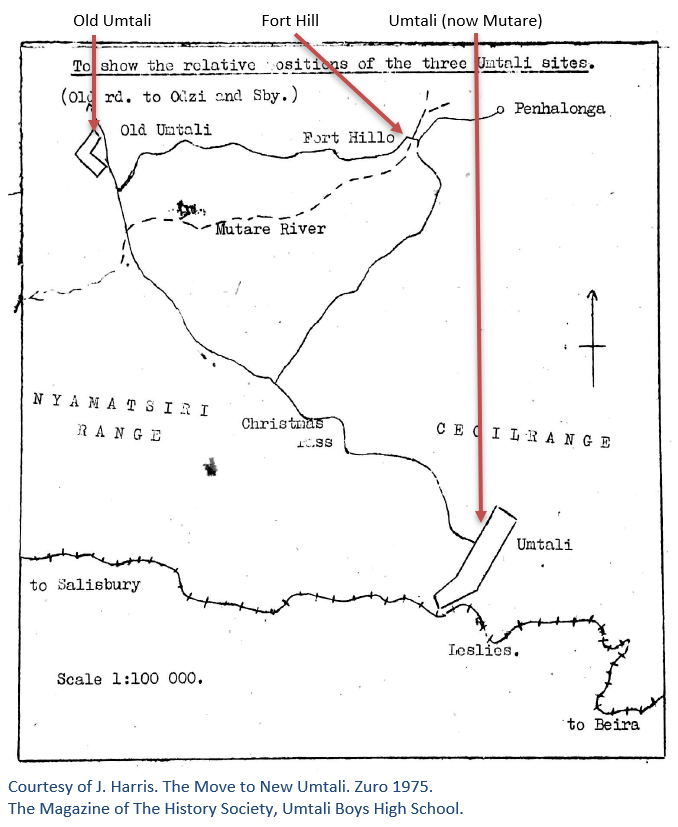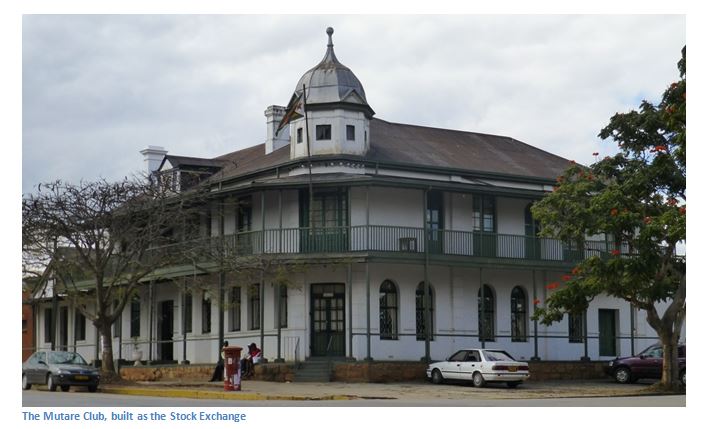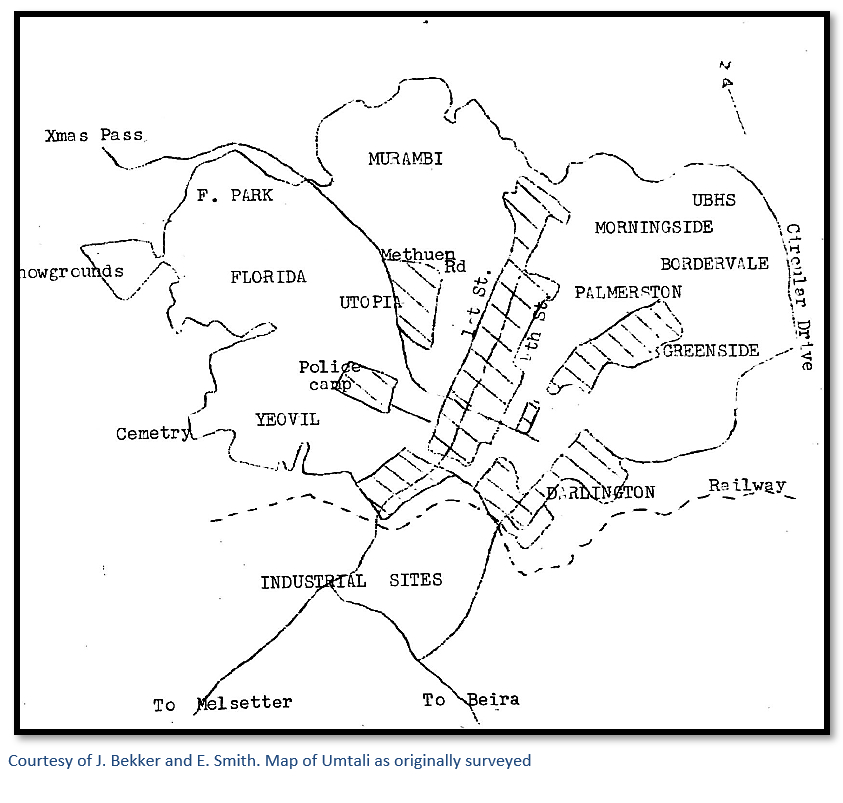Mutare (formerly Umtali)
From Harare on the A3 national road, Mutare is 263 kilometres.
GPS reference: 18⁰58′22.09″S 32⁰40′15.68″E
Mutare (previously known as Umtali) is Zimbabwe's third largest city with a population of 188,243 (2012 Census) and is the provincial capital of Manicaland Province, the most populous province in Zimbabwe, having more than a million people within its hinterland. Often called "the Gateway to the Eastern Highlands", many Zimbabweans refer to it as Kumakomoyo “place of many mountains” as it is located within a bowl-like valley south of the Imbeza Valley and north of the Bvumba Mountains which divide Zimbabwe and mozambique. The border is just eight kilometres away and Mutare has always been considered the country’s gateway to the sea with the Beira Corridor linking Zimbabwe to the Mozambican port of Beira, only 290 KM away. Good tar roads connect the Mutare with the rest of the country, the A3 route to Harare going over Christmas Pass on the road to Harare and historically the town connects Beira with Harare and Bulawayo via the railway network.
The origins of the word Mutare may be from the word 'Utare' meaning “piece of metal” being the name probably given to the Mutare River as a result of gold being discovered in the Penhalonga valley.
Mutare’s original location was at Fort Hill [See the separate article under Fort Hill - the first site of Umtali] but in 1891, for health reasons and because of local mining activities that threatened to impede future expansion, the town moved to a site now known as Old Umtali, about 14 kilometres north of present day Mutare. The Police camp and Government buildings were erected on this site on the Mutare River and by 1895 the new township included 78 men, 13 women and 9 children. [See the article on Old Umtali – the second site]
Move from Old Umtali
The prime source of the following is from an article by J. Harris The Move to New Umtali which appeared in Zuro 1975 the Magazine of The History Society, Umtali Boys High School.
Late in 1895 Mansergh, the Beira Railway Company’s surveyor, reported that it would be costly and impractical to take the rail line over Christmas Pass and recommended the route along the valley of the Sakubva River and over the Nyamashiri Range to the Odzi River, the next big obstacle.
George Pauling in his book The Chronicles of a Contractor says in his capacity as Commissioner of Public Works that he proposed to Cecil Rhodes that old Umtali should be moved to the site of the present Mutare and that the BSACo could offer corresponding sites and pay the townsfolk for the buildings they had erected at Old Umtali and says that with the surveyor he selected the present site.
Rhodes was in the country having recently resigned as Prime Minister of the Cape following the Jameson Raid and on 26 March 1896 held a meeting with the residents of Old Umtali. The choice was clear: either the town moved to the planned site of the new railway station, or it remained where it was and became an isolated backwater. There was much debate on the conditions under which the move would take place.
Finally the meeting agreed that the town would have to move and the owners of stands in Old Umtali would be given corresponding position in the new town with valuations of all buildings in the old town being calculated for which the BSAC would pay the owners. If residents considered their newly allocated stands were unfavourably situated, they could exchange them for unsold stands. In addition, the BSAC would build suitable government buildings and a hospital and provide money for a water supply at the new site.
A selection committee consisting of Sir Charles Metcalfe, Mansergh, Pickett and Suter choose the final site at the farms Sable Valley, Birkley and Mountain View and paid out £5,000 to the owners. Landowners in Old Umtali applied to the Surveyor-General, J. M. Orpen, to allocate new stands on the new site.
In May 1896 the townsfolk of Old Umtali decided that the Sanitary Board was not representative enough and required more members; their last meeting was held at Old Umtali on 11 August 1897. From the beginning of the year people had begun moving to the new site and commencing building operations. Old Mutare was literally pulled to pieces and all the building materials hauled over Christmas Pass and reassembled on the new site of Umtali. For a period the population of ninety European was equally split between the two towns, but as more and more wood and corrugated-iron was hauled by ox-wagon over the Pass the new town gradually began to take shape of predominately of dhaka and thatched cottages. There was a shortage of local labour in the town as memories and distrust from the Mashona Rebellion or First Chimurenga still lingered; their places were taken by newcomers from Portuguese East Africa and the Zambezi Valley.
Total compensation paid out by the BSACo amounted to over £300,000 and this spending power and the arrival of the first train at Umtali on 4 February 1898, having left Beira the day before, that resulted in a mini-boom in the town’s fortunes. Although it was narrow gauge (2 ft) and limited to 50 ton loads, the railway did mean regularly scheduled transport with coast at Beira.
One of Mutare’s architectural gems is the Mutare Club, designed by James Cope-Christie in 1897 which still looks very stylish at the junction of Herbert Chitepo Street (formerly Main Street) and Fifth Avenue. This was originally designed as the Stock Exchange, a sign of the exuberant spirits of the time when 160 gold mines were in the early stages of development in the Penhalonga / Mutare area. There are signs of previously chic 1930’s homes in the Avenues, the brilliant scarlet blossom of the flamboyant trees lining the streets, but many now look faded and uncared for. The Marange diamond money has evidently flown into the Banks of Dubai, or Singapore, rather than Mutare. To soak in some historic flavour, try the old Hospital at The National Gallery of Zimbabwe at the corner of Third Street and Eleventh Avenue, or Utopia House on Jason Moyo Drive, opposite St Dominic’s Girl School.
The 1896 settlers, had to contend with hazardous roads before reaching the new site, and on arriving, buildings of every conceivable size and shape were already being constructed on the ten acres stands that were allotted to them; wattle and daub with thatched roofs were most prominent, as these materials were easily obtainable, but any available piece of iron, wood and timber went into the buildings. Public buildings for the Civil Commissioner and Magistrate were speedily erected in 1897, initially a small thatched hut, beside it a building of wood and iron. Other wood and iron buildings included Mrs. Hayne's tearoom, Corderoy & Reynolds Store, the Cecil Hotel was a plain block building without a verandah, the front portion being a bar.
Bekker and Smith state that in the early days of Umtali there were no less than thirteen hotels, clubs and canteens which were continually changing ownership. In 1898 a brewery opened business but could not compete with the imported duty-free beers and soon closed down, although the creek where it was sited retained the name “brewery creek.”
The Public Works Department supervised the building of the Adams Hotel and eventually the hotel became the Umtali Club in 1900, which remains to this day. Construction of Government Offices, the Residency, the Drill Hall with all its stables, and the Stock Exchange were started. The Goal seems to have had priority, the workmen being inmates were allowed out on parole during the day. In the evenings they were obliged to report back, and often could be seen knocking on the goal door seeking admittance. The Kopje House Hospital was also started in that year, a great necessity for the sick men constructing the railway from Beira and the Odzi Railway Bridge that was also being built at that time. [See the article on the National Gallery that occupies Kopje House on the website www.zimfieldguide.com]
Many malaria cases developed into blackwater and the original stream acquired the name Black Water spruit because it was thought that the water from the stream was responsible. So the Sanitary Board sank a borehole in Market Square, and this became the old-time village pump, and was very much in demand.
Lions and leopards remained a serious menace; a donkey was killed in Main Street in front of the newly erected Post Office. They often came at night when all was quiet, taking dogs, hens and pigs and the occasional cow and a calf near a homestead. One Umtali resident set a jaw spring trap tied by a chain to a paraffin tin, a lion or leopard caught its foot in the trap and went tearing terrified down Main Street, the paraffin tin making an unearthly din, and waking all the inhabitants.
The Stock Exchange, an imposing double storey building was begun in 1897 as mining was thriving and some mines in Penhalonga were exceptionally good. The Stock Exchange thrived right up to 1924, but then market declined, when it was realised that Umtali was not going to be a second Johannesburg. Today the building serves as The Mutare Club.
Mutare once boasted of the only tramway in Zimbabwe which transported passengers from the Railway station up the centre of Main Street where the palm trees now stand to the Mutare Club. The necessary capital was raised, but work was not started until July 1901 by George Hall, the contractor. He carried out the work smoothly and with plenty of labourers, the line was laid in a month, from the Railway Station to the top end of the town. The day following completion, Hall invited the residents to journey over the new track on trolleys, and thus the first passengers were carried on a street tramway in Rhodesia. The passenger cars were supplied by an American company, Jackson Sharp & Company, each nineteen feet long and seating eighteen passengers, and drawn by two mules; but as these cars were too heavy for the track and too slow, most passengers preferred to walk. One time a visiting football team pushed the tramcar all the way up Main Street to the Club, where their thirst got the better of them. The tramcar was forgotten and remained outside the Club for a very long time. The Sanitary Board considered it was the duty of the Club to return it to its quarters; the Club put the onus on the Tramway Company. However, after about a year the tram car was somehow returned. The tramway operated until 1914, when motor lorries appeared on the streets to cart goods.
The first travelling theatre to visit Umtali in 1904 was the Sass & Nelson Company, a tremendous thrill for Umtali. The Royal Hotel boasted a fairly large stage and when the theatre company arrived announced their intention was to stay a week in Umtali and put on a new play every night, many people booked for the whole week. Plays such as "The Bell of New York", "Merry Widow", with a change of scenes, were much appreciated by all. After a week of intense excitement and enjoyment, the town returned to normal.
Brick-fields were laid out on the site now known as Riverside. On one occasion a lion chased a donkey over some freshly made bricks spread on the ground to dry, before it was killed. A great bricks were spoiled, but some very good specimens of the lion's spoor remained and after being baked, were displayed in the Club.
There were some unusual homes. A man called Engelbrecht built a house from bottles, which were easy to come by as the hotels were only too pleased to get rid of them. The only drawback to living in a glass house was small boys throwing stones at it. Eventually Engelbrecht was forced to plaster the walls. The building remains standing today and is still being lived in.
Climate
Despite Mutare's tropical location, the city has a temperate climate, with an average annual temperature of 19°C; this is due to its sheltered location amongst the mountains. The coldest month is July (minimum 6°C and maximum 20°C) and the hottest month is October (minimum 16°C and maximum 32°C). Most rain falls in the months December to February, although showers occur outside this period.
Main Economic Activities
Forestry - Mutare is situated in the heart of Zimbabwe’s timber growing areas. The timber grown locally includes softwoods, such as pine, blue gum and black wattle and hardwoods on a smaller scale and from this derives timber based industries such as board and paper, joinery, roof trusses, and furniture manufacturing for local and export markets.
Local Agricultural products include apples, bananas, grapes, oranges, tomatoes, peas, and beans. Large commercial operations produce tea, coffee, wheat, cotton and tobacco which give rise to agro-processing industries for canning, freeze-drying and packing these resources. Two large food producers in Zimbabwe, Cairns Foods and Tanganda Tea, have their headquarters in Mutare.
Mutare has some of the finest education and manpower training facilities in the country including The Zimbabwe College of Forestry, SADC Forestry Technical College, Mutare Technical College, Africa University, Mary Mount Teachers College, and Mutare Teachers College.
Mining has contributed much in the past; production has been estimated at 73 tonnes of gold in the Mutare Gold belt, but apart from Redwing and some smaller mines and illegal mining, this activity has dwindled in recent years. There are high yielding diamond fields in Marange, but the country has benefited very little from these recent finds whose output remains secret and unaccountable.
Tourist Attractions
Manicaland, including the hinterland of Mutare, has a wide range of tourist resorts and facilities including:
Nyanga Mountains for scenic views, mountain climbing, hiking and horseback riding
Bvumba Mountains also for captivating scenery and lush botanical gardens
Mutare Museum
Utopia House Museum dedicated to Kingsley Fairbridge
National Gallery of Zimbabwe
Murahwa Hill - Iron Age village and rock paintings
Cross Kopje - memorial to Zimbabweans and Mozambicans killed in World War I
The Courtauld Theatre
Acknowledgements
C.M. Hulley’s Memories of Manicaland
J. Bekker and E. Smith. Early Days in Umtali 1888 – 1898. Zuro 1971. The Magazine of The History Society, Umtali Boys High School.



